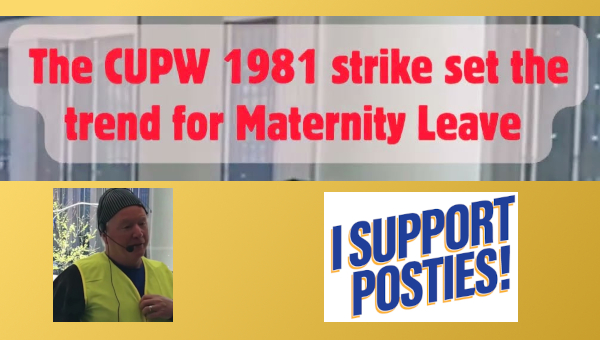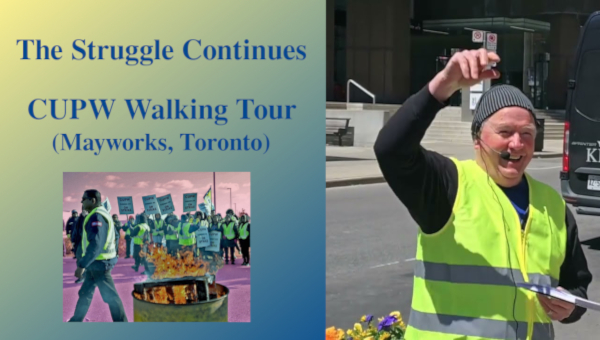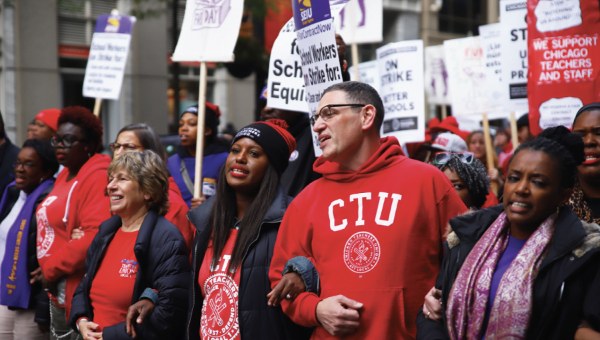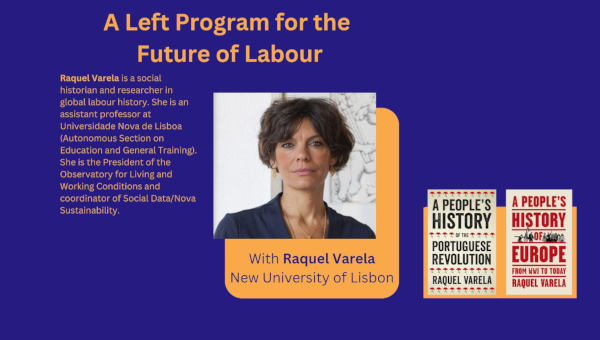The UPS Agreement in its ‘Concrete Context and Outcomes’: A Response to a Response
In an earlier discussion of the recent Teamster-UPS Agreement, I decried the generally uncritical cheerleading of the agreement and cited Barry Eidlin as someone who at least thoughtfully ‘raised important qualifications’. Eidlin, however, seems determined to prove me wrong in my praise.
In a counter to my assessment, Eidlin states that my critique “provides a good roadmap for socialists organizing in the workplace as to what to fight for going forward.” But he quickly adds that “as a concrete analysis of the context and outcomes surrounding the contract, it falls short.”
Had he continued along these lines and struggled with how to wed the two challenges – the “fight for going forward” and the concrete “analysis of the context and outcomes” of the Teamster contract – I would have again commended him. What we get instead is a passing nod to a socialist orientation that is immediately set aside for one more ultimately narrow defence of the agreement.
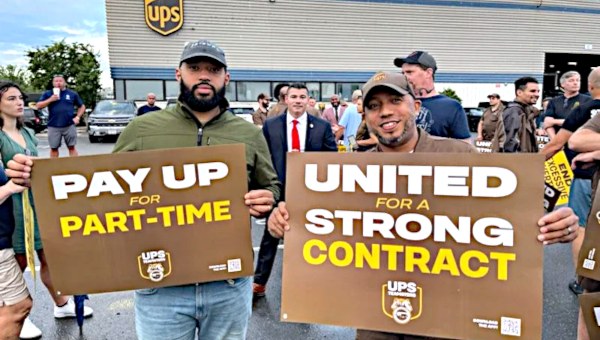
Assessing ‘success’
The UPS contract was a test for the ‘new’ Teamsters and, indirectly, for a possible reorientation of the North American labour movement. The incumbent slate had been defeated by a leader, Sean O’Brien, talking a tougher line toward the company. He was enthusiastically supported by the long-time oppositional TDU (Teamsters for a Democratic Union) and welcomed with wild enthusiasm by thousands of labour activists seeking inspiration at the 2022 Labor Notes Biennial Conference. Most importantly, UPS was raking in the profits, aided by the pandemic, and extremely vulnerable to a work disruption. What better moment to take on UPS?
Eidlin’s assessment is unambiguous: “This is the best UPS contract ever negotiated.” If one sees past Teamster agreements – other than the one reached after the 1997 strike – as repeated examples of the limits of business unionism, the comparison to the past is, indeed, faint praise. As for 1997, why was that agreement, entailing as it did a national strike and popularly seen as leading the fight against precarious work, so easily dismissed by Eidlin in the context of “best contract ever”?
The answer seems to be that Eidlin’s measure of union success is primarily anchored in the size of the wage increases, not the principles addressed, the struggle undertaken, or the impact on building collective working-class power in the workplace and beyond. This measure of success reflects the hold of the culture of business unionism, or at least more militant versions of it. If Eidlin wanted to make comparisons to the past, a far better route would have been to introduce today’s Teamsters to the remarkable role their forbearers played in the 1930s breakthrough to industrial unionism (see Bryan Palmer, Revolutionary Teamsters: The Minneapolis Truckers’ Strikes of 1934).
‘Concrete’ Criticisms?
Eidlin’s specific criticisms of my take begin with asserting that the Teamsters did, in fact, address the second-class status of part-timers. He asserts that I was ‘flat out wrong’ about the promised creation of full-time jobs and insists that the union also addressed working conditions. He confidently concludes that the Teamsters, strategically backed by the TDU, played its cards near perfectly and are consequently now in a better position to move on to the ‘broader issues’ still outstanding. A few brief responses before returning to the larger questions at hand.
- I never argued that the part-timers didn’t get a solid wage increase. My argument was rather that increasing the wages of part-timers, which is obviously welcome, is, nevertheless, distinct from a crusade identifying the UPS wage structure as an affront to worker solidarity. It was this principle that was not ideologically and organizationally challenged in the pre-bargaining education-organizing preparations and, consequently, reinforced the normalization of a lower status of part-timers. A sign of that normalization was that the agreement, in fact, introduced a new tier among the part-timers themselves. It is not adequate to just acknowledge this, as Eidlin does; it needs sustained attention for what it reveals about the internal stratifications of the members and the strategic limits in the bargaining of the collective agreement.
- My skepticism over UPS’s acquiescence to correcting the rise in part-time work by ‘converting’ part-time jobs to full-time ones was based on this being an easy fudge for UPS and was reinforced by a quick look at the outcome of similar commitments in the past. Going into the 1997 agreement, the proportion of part-timers at UPS was 58%. In the next agreement in 2002 (a six-year agreement), the union won a similar commitment. After all this, the proportion of part-timers going into the current agreement was 60%, indicating no improvement at all in spite of the promised changes. Using such false promises to help sell agreements is at best naïve and at worst cynical.
- Eidlin’s declaration that it is absurd to think that the position of part-timers could be ended ‘in a single contract’ is a misleading straw man. Fully reversing such defeats takes time: that’s why they are so costly. The issue is rather whether the principle of equal status among members was seriously taken up as a step toward achieving it over time. It wasn’t.
- My essay did credit the Teamsters with improving the conditions of drivers. But what I pointed to was that the part-timers, who are overwhelmingly warehouse workers, saw no such attention to their work conditions. The record of health and safety in warehouses is dismal, and the ongoing stresses of corporate speed-ups in the warehouses is a critical cause. This is significant not only to the daily lives of UPS warehouse workers but also to the Teamsters strategic goal standing in the wings of these negotiations: the agreement’s potential influence on the unionization of the Amazon warehouse workers.
- As for the TDU, I explicitly did not criticize them for supporting O’Brien’s election. The issue I emphasized was rather in effectively surrendering their independent role in broadening the scope of the demands and struggle in the union at a moment when it was most needed. It can be tricky to balance the relationship of opposition groups to union leadership, but it’s a reality of working for internal changes in unions. That battle cannot be won if those who see themselves as the strategic soul of the union voluntarily silence themselves.
- Eidlin concludes by turning, finally, to the question of building the movement. Yet, what he studiously and revealingly sidesteps is the negative impact of five-year agreements on union strength (acknowledged by Teamster reform president Ron Carey in 1997 even though he reluctantly accepted it). Long agreements provide the company ample time to restructure work so as to recover a good part of what they gave up to avoid a work disruption. And the aura of ‘class peace’ does not bode well for expectations of continued struggle and building during the life of the agreement. Indeed, crucial union struggles may well suffer – whether in terms of increased discussions over ending the inferior status of particular workers, resistance to the daily indignities and pressures at work, or a renewal of an organized opposition with a more ambitious and class-focused agenda.
One-Sided Class War
Adding the caveat ‘but’ after declaring the UPS agreement a great settlement does not mean very much if the ‘but’ is then largely ignored. It is the ‘but’ that socialists in particular must highlight and explore.
It seems apparent that for this set of negotiations the Teamster leadership was willing to prepare for a strike, yet quite careful to avoid crossing lines that might make a strike necessary. The offer to UPS – implicit or overt – was at its core that if UPS made an across-the-board wage offer that is high enough (and deals minimally with certain other frictions) the union will not strike, will accept UPS retaining a wage structure that accepts two classes of workers, will live with the prior practice of five-year agreements, and will not challenge working conditions in the warehouses.
The Teamsters did get the higher wages, and that’s where the ‘but’ comes in. It is not enough to fight for the end of corruption in unions, as the TDU inspiringly did in the past, but let the fight for democracy end there. Five-year agreements limit worker participation and thereby limit effective worker democracy. Similarly, preaching class solidarity in society while tolerating two tiers of workers in union workplaces is too hypocritical to get us ‘somewhere else’. And emphasizing pay but ignoring what daily happens to workers’ bodies and minds is an abdication of respecting workers as having far more potential than just selling their labour power to the company.
No favour is done the labour movement when we cheer on agreements that don’t take on the inequalities of power and principles in workplaces and then give these agreements the status of being ‘historic’. Nor is a favour done when we exaggerate labour’s strength. The larger context here is that the American labour movement, like their counterparts almost everywhere, have been in crisis for decades now. What is desperately needed is for all of us in the labour movement to come to grips with a core feature of this political moment. It’s not enough to complain about the hostile external context: we must start confronting – throughout all levels of the labour movement and among socialists – our own weaknesses.
In 1978, Doug Fraser, then head of the UAW, lashed out in frustration against corporations that wanted a stable relationship with labour but ‘have, with few exceptions… chosen to wage a one-sided class war today’. His threat was to make this assault into a two-sided war. The UAW “intends to reforge the links with those who believe in struggle: the kind of people who sat-down in the factories in the 1930s and who marched in Selma in the 1960s.”
That threat did not materialize. The result was the notorious period of concessions and restraint that working people are still suffering through. The question it leaves us with is why was Doug Fraser’s challenge not taken up? After all these years of concessions and restraints, of accelerated technology and regular productivity improvements tempting us with a future of easier and better lives but bringing instead families working harder and more hours than ever before, and leaving us with capitalism having less social legitimacy than it has had for generations, why have we not seen widespread rebellions either in workplaces or in society as a whole?
Conclusion: Beyond Unions?
As we analyze the nitty-gritty details of collective agreements, two caveats are fundamental. First, we must do so honestly and soberly, resisting the urge to find what we wish to see or misleadingly giving them a gloss to serve desires, in such difficult times, for inspirational examples. Debates and discussions about the Teamster-UPS agreement are a check on such predilections. Second, we must not get lost in the details and instead keep returning to the larger issues that collective bargaining and class conflicts pose and the context they reflect.
Such issues do not just go ‘beyond unions’. Asking whether the enemy is the boss or the capitalist system, is to ask what a class approach means in a union context. It means that confronting the limits of even the best unions is fundamental to informing union struggles and their transformation. It involves going ‘beyond unions’ in the sense of asking whether better unions and more successful union struggles demand other kinds of working-class organizations. It is to pose the need for socialist parties with one foot in the unions and one outside – so they are grounded in the lives and struggles of the working class, including their contradictions, but not trapped by them. It is these larger issues in particular that we confront and debate far too rarely. •


